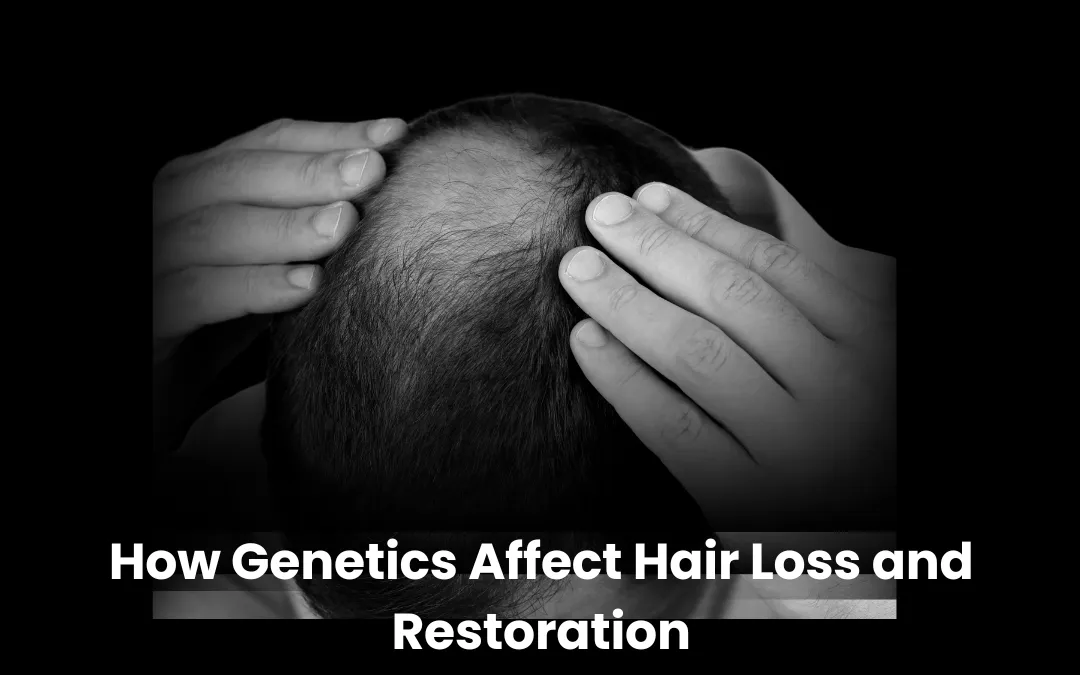Hair is a defining feature of self-image, shaping how people perceive themselves. However, hair loss can be a distressing experience, affecting both men and women. While several factors contribute to hair thinning, genetics is one of the most significant.
“Studies suggest that more than 80% of male pattern baldness cases and a considerable percentage of female hair loss cases are linked to hereditary factors. If one or both parents experienced hair thinning, the likelihood of inheriting the trait increases substantially.”
The good news?
Advances in hair transplant in India and innovative restoration methods offer effective solutions for those struggling with hereditary hair loss. With a team of highly skilled hair transplant surgeons and world-class facilities, QHT Clinic is among the best hair transplant clinics in India.
Understanding Genetic Hair Loss
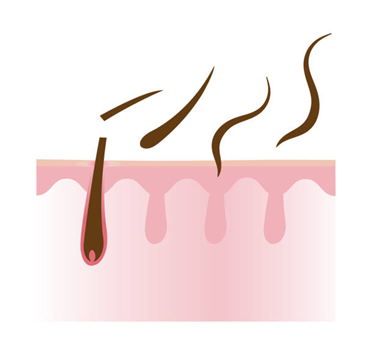
Genetic hair loss, also known as hereditary alopecia, occurs when specific genes passed down through generations influence hair follicle sensitivity and longevity. Unlike temporary hair shedding, this type of hair loss is gradual and progressive.
Family History Matters: If close relatives have experienced baldness or thinning, there’s a high probability that genetics are at play.
Chromosomal Influence: While once believed to be passed primarily from the mother’s side, research suggests that genes from both parents contribute to hair loss patterns.
Hair Follicle Sensitivity: The inherited sensitivity of hair follicles to hormonal changes, particularly Dihydrotestosterone (DHT), is a primary cause of genetic hair loss.
Androgenetic Alopecia: The Most Common Genetic Hair Loss
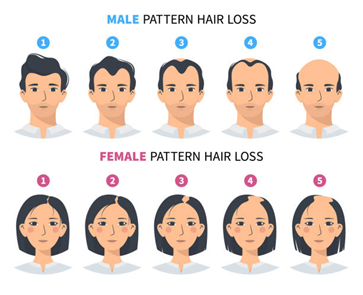 Androgenetic Alopecia, commonly known as male and female pattern baldness, is the leading cause of hereditary hair loss worldwide. It affects over 50 million men and 30 million women in India alone.
Androgenetic Alopecia, commonly known as male and female pattern baldness, is the leading cause of hereditary hair loss worldwide. It affects over 50 million men and 30 million women in India alone.
- Male Pattern Baldness (MPB): Typically starts with a receding hairline and thinning crown, eventually leading to complete baldness.
- Female Pattern Baldness (FPB): More diffused thinning, usually noticeable along the part line, but rarely results in complete baldness.
The Role of DHT: DHT, a byproduct of testosterone, binds to hair follicles and gradually shrinks them. This miniaturization process shortens the hair growth cycle until follicles stop producing hair altogether.
“Genetic hair loss is not just about losing strands; it’s a complex process influenced by hormones, family history, and individual follicular sensitivity. Understanding the root cause is essential in choosing the right treatment path,”
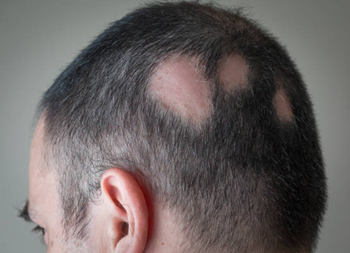 Other Genetic Hair Loss Conditions
Other Genetic Hair Loss Conditions
Apart from androgenetic alopecia, some lesser-known hereditary conditions can lead to hair loss:
Alopecia Areata: An autoimmune disorder where the body attacks hair follicles, leading to patchy bald spots.
Congenital Hypotrichosis: A rare genetic condition causing hair loss from birth or early childhood.
Marie Unna Hereditary Hypotrichosis: Leads to progressive hair loss, typically starting in adolescence.
Wondering if it’s too late to act on your genetic hair loss? Consult a hair restoration expert today to find the best approach for preserving your hair.
Diagnosing Genetic Hair Loss
Identifying genetic hair loss involves recognizing patterns and undergoing medical evaluation:
Observing Hair Loss Patterns: Is hair thinning following a recognizable pattern?
Family History Assessment: A thorough look at immediate and extended family members can provide clues.
Genetic Testing: Advanced tests analyze DNA markers to determine predisposition to baldness.
Body hair transplant expert says:
“While genetics cannot be changed, effective treatments can slow or reverse hereditary hair loss. From non-surgical options to advanced restoration techniques, modern dermatology offers promising solutions.”
Hair Restoration Options for Genetic Hair Loss
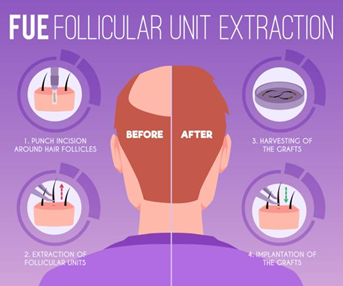
Hair Transplants: A Permanent Solution
The best hair grafting in India involves advanced FUE (Follicular Unit Extraction) and QHT (Quick Hair Transplant) methods. These techniques relocate healthy follicles from donor areas to bald spots, ensuring natural and long-lasting results.
Medications and Topical Treatments
- Minoxidil: Stimulates follicles to extend the hair growth phase.
- Finasteride: Blocks DHT, preventing further hair miniaturization.
Advanced Therapies: PRP and Stem Cell Treatments
- Platelet-Rich Plasma (PRP): Uses growth factors to stimulate hair regrowth.
- Stem Cell Therapy: Encourages follicular regeneration, improving hair density.
Can genetic hair loss be reversed? With advancements in hair restoration, it’s possible to regain natural-looking hair. Get expert advice from a specialist to understand your treatment possibilities.
Other Contributing Factors to Hair Loss
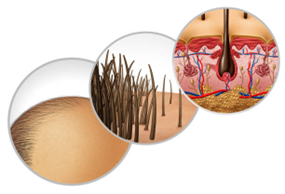 While genetics play a primary role, external factors can exacerbate hair loss:
While genetics play a primary role, external factors can exacerbate hair loss:
Nutritional Deficiencies: A lack of essential nutrients like iron, biotin, and protein weakens hair strands, making them brittle and prone to shedding. Without these nutrients, hair follicles struggle to support healthy growth, leading to noticeable thinning over time.
Chronic Stress: Prolonged stress raises cortisol levels, which disrupts the natural hair growth cycle and pushes more follicles into the shedding phase. This condition, known as telogen effluvium, can cause significant hair loss, especially during periods of extreme emotional or physical strain.
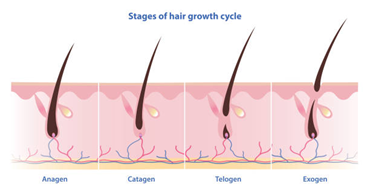 Medical Conditions: Hormonal imbalances from thyroid disorders, polycystic ovary syndrome (PCOS), diabetes, or autoimmune diseases like alopecia areata can weaken hair follicles. These conditions interfere with the hair’s natural renewal process, often causing patchy or widespread thinning.
Medical Conditions: Hormonal imbalances from thyroid disorders, polycystic ovary syndrome (PCOS), diabetes, or autoimmune diseases like alopecia areata can weaken hair follicles. These conditions interfere with the hair’s natural renewal process, often causing patchy or widespread thinning.
Choosing the Right Hair Restoration Approach
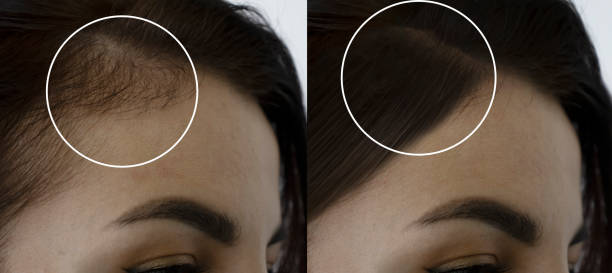
- Hair Transplants: Best for advanced hair loss cases.
- Medications: Can slow hair thinning and encourage regrowth.
- Non-Surgical Therapies: PRP and laser treatments improve hair density.
- Lifestyle Adjustments: A nutrient-rich diet, stress management techniques, and proper scalp care help maintain existing hair and support overall hair health.
Each individual’s hair loss journey is different. Consulting a specialist can help determine the most suitable treatment based on hair type, medical history, and the extent of hair thinning.
Final Thoughts: Managing Genetic Hair Loss Effectively
Are you considering hair restoration procedures but not sure where to start? Schedule a consultation with a hair restoration expert today.
Frequently Asked Questions
- Can Your Genes Affect Hair Transplant Success?
While the transplanted hair is resistant to DHT-related thinning, the surrounding native hair may continue to shed if hair loss progresses. A specialist can assess whether additional treatments are needed to maintain long-term results.
- Can Genetic Hair Loss Be Diagnosed Early?
Yes, genetic hair loss can be identified early by observing changes in hair density, thinning patterns, and family history. Dermatologists can also use scalp analysis and genetic testing to assess hair loss risks, allowing for early intervention with medications or lifestyle adjustments.
- Is Hair Restoration the Best Option for Genetic Hair Loss?
Hair restoration is the most effective solution for advanced genetic hair loss, especially for those who have significant thinning or bald patches. However, the best approach depends on individual factors, and treatments like medications, PRP therapy, and lifestyle modifications can help slow hair loss before considering surgery.
- At what age does genetic hair loss typically begin?
It can start as early as the late teens or early twenties but varies based on individual genetic predisposition.
- How do I know if I need a hair transplant?
If hair loss significantly impacts confidence and non-surgical treatments prove ineffective, a consultation with a hair surgeon in India can help determine candidacy.
Reference Links:
https://www.health.harvard.edu/a_to_z/hereditary-patterned-baldness-a-to-z
https://www.aad.org/public/diseases/hair-loss/treatment/transplant
Disclaimer: The information shared in this content is for educational purposes only and not for promotional use.

